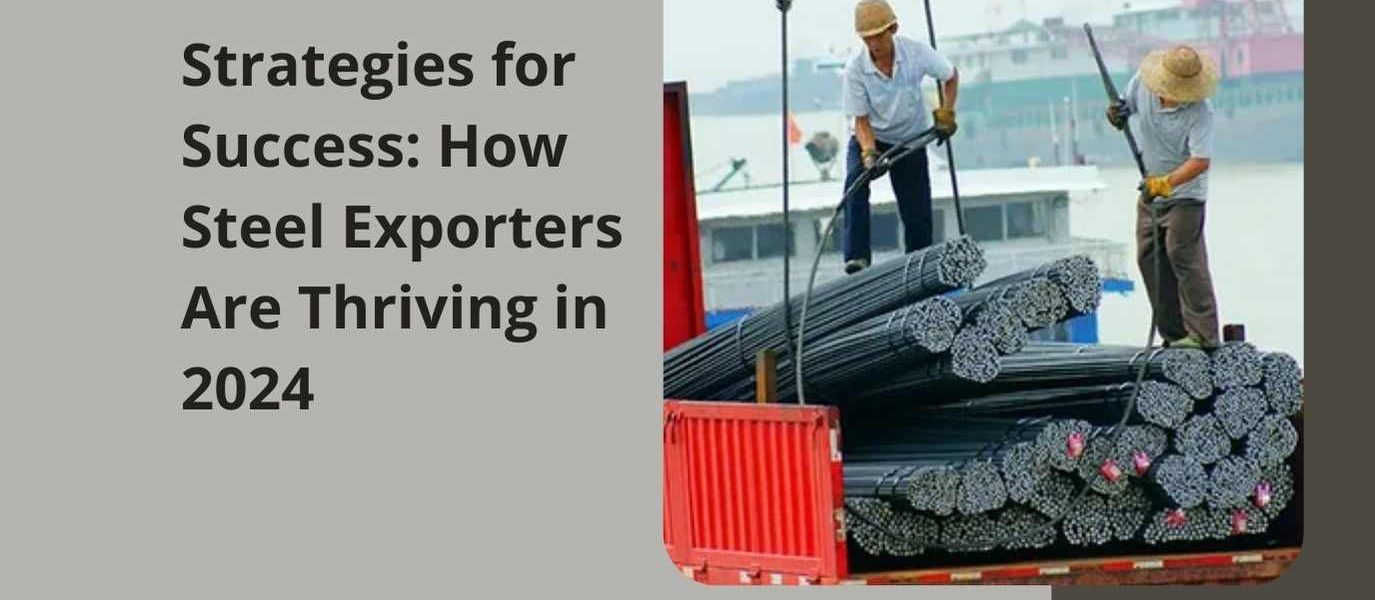Steel exporters face a dynamic and competitive global market. As of 2024, various strategies have emerged that allow these businesses to not only survive but thrive. This blog will explore the key strategies that steel exporters are using to ensure their success in today’s market.
Understanding the Global Steel Market
The Current State of the Steel Industry
The steel industry in 2024 is marked by significant challenges and opportunities. Global demand for steel continues to grow, driven by construction, automotive, and manufacturing sectors. However, competition is fierce, and exporters must navigate complex trade regulations, fluctuating prices, and environmental concerns.
Key Markets for Steel Exporters
Steel exporters are focusing on key markets where demand is high. Asia, particularly China and India, remains a major consumer of steel due to rapid industrialization and infrastructure projects. Additionally, North America and Europe continue to be significant markets, though they require compliance with stringent quality and environmental standards.
Trends Shaping the Steel Industry
Several trends are influencing the steel industry in 2024. These include advancements in steel production technology, increasing emphasis on sustainability, and shifts in trade policies. Exporters need to stay informed about these trends to remain competitive.
Strategies for Success
Investing in Advanced Technology
Embracing Innovation
Steel exporters are investing in advanced technologies to improve efficiency and product quality. Innovations such as automation, artificial intelligence, and data analytics are helping companies streamline their operations and reduce costs. For example, predictive maintenance systems can help prevent equipment failures, ensuring smooth production processes.
Enhancing Product Quality
High-quality steel products are essential for maintaining a competitive edge. Exporters are adopting new production techniques, such as electric arc furnaces and continuous casting, to produce superior steel grades. These technologies not only enhance quality but also reduce energy consumption and emissions, addressing environmental concerns.
Focusing on Sustainability
Reducing Carbon Footprint
Sustainability is a critical focus for steel exporters in 2024. Companies are implementing measures to reduce their carbon footprint, such as using recycled materials and adopting energy-efficient processes. Green steel, produced with minimal environmental impact, is becoming increasingly popular among environmentally conscious consumers.
Compliance with Environmental Regulations
Compliance with environmental regulations is essential for accessing key markets. Exporters must stay updated on the latest regulations and ensure their operations meet or exceed these standards. This not only helps in avoiding penalties but also enhances the company’s reputation as a responsible business.
Strengthening Supply Chain Management
Building Resilient Supply Chains
Supply chain disruptions can significantly impact steel exporters. To mitigate risks, companies are diversifying their supplier base and investing in robust logistics networks. Building strong relationships with reliable suppliers ensures a steady flow of raw materials and components, minimizing production delays.
Adopting Digital Supply Chain Solutions
Digital supply chain solutions are revolutionizing how steel exporters manage their operations. Technologies like blockchain, Internet of Things (IoT), and cloud computing provide real-time visibility into the supply chain, enabling better decision-making and reducing inefficiencies.
Enhancing Customer Relationships
Understanding Customer Needs
Customer satisfaction is crucial for long-term success. Steel exporters are investing in customer relationship management (CRM) systems to better understand their clients’ needs and preferences. Personalized service and tailored solutions help in building strong, lasting relationships.
Offering Value-Added Services
Beyond providing high-quality steel products, exporters are offering value-added services such as custom fabrication, technical support, and logistics management. These services enhance customer satisfaction and differentiate the company from competitors.
Navigating Trade Policies
Staying Informed About Trade Regulations
Trade regulations can have a significant impact on steel exports. Exporters must stay informed about changes in tariffs, trade agreements, and import/export restrictions. Proactive management of compliance ensures smooth international transactions and avoids costly delays.
Leveraging Trade Agreements
Trade agreements can open up new markets and reduce barriers to entry. Steel exporters are actively seeking opportunities to leverage existing trade agreements and advocate for new ones. By doing so, they can expand their market reach and increase sales.
Fostering Innovation and R&D
Investing in Research and Development
Continuous innovation is key to staying competitive. Steel exporters are investing in research and development (R&D) to create new products and improve existing ones. R&D efforts focus on developing stronger, lighter, and more sustainable steel grades.
Collaborating with Research Institutions
Collaboration with universities and research institutions can accelerate innovation. Exporters are partnering with academic institutions to access cutting-edge research and technology. These collaborations often lead to breakthroughs that give companies a competitive edge.
Financial Management and Risk Mitigation
Effective Financial Planning
Sound financial management is critical for success in the steel export business. Exporters are implementing robust financial planning and budgeting practices to manage cash flow and investment. This includes careful analysis of market trends and cost control measures.
Risk Mitigation Strategies
Risk is an inherent part of the export business. To mitigate risks, companies are using tools such as hedging to protect against price fluctuations and currency exchange risks. Insurance products also help in safeguarding against potential losses from unforeseen events.
Case Studies of Successful Steel Exporters
Company A: Embracing Sustainability
Company A, a leading steel exporter, has successfully integrated sustainability into its operations. By investing in green technologies and adhering to strict environmental standards, the company has gained a competitive edge in markets that prioritize sustainability. Their commitment to reducing carbon emissions has not only enhanced their reputation but also attracted environmentally conscious customers.
Company B: Leveraging Technology for Efficiency
Company B has leveraged advanced technologies to streamline its production processes. By adopting automation and data analytics, they have significantly reduced operational costs and improved product quality. Their efficient supply chain management has ensured timely delivery of products, strengthening their relationships with clients.
Company C: Expanding Through Trade Agreements
Company C has strategically expanded its market reach by leveraging trade agreements. By staying informed about trade policies and advocating for favorable agreements, they have accessed new markets with reduced trade barriers. This proactive approach has led to substantial growth in their export volumes.
Conclusion
In 2024, steel exporters are thriving by adopting innovative strategies that address the challenges and opportunities of the global market. By investing in advanced technology, focusing on sustainability, strengthening supply chain management, enhancing customer relationships, navigating trade policies, fostering innovation, and practicing effective financial management, these companies are setting themselves up for long-term success.
Steel exporters must continue to evolve and adapt to remain competitive in a rapidly changing industry. The strategies outlined in this blog provide a roadmap for achieving success in 2024 and beyond. By embracing these approaches, steel exporters can not only survive but thrive in the global market.
Key Takeaways
- Invest in Technology: Automation, AI, and data analytics are essential for improving efficiency and product quality.
- Focus on Sustainability: Reducing carbon footprint and complying with environmental regulations can enhance reputation and market access.
- Strengthen Supply Chain: Diversifying suppliers and adopting digital solutions ensure resilience and efficiency.
- Enhance Customer Relationships: Understanding customer needs and offering value-added services build loyalty.
- Navigate Trade Policies: Staying informed and leveraging trade agreements can open new markets.
- Foster Innovation: Continuous R&D and collaboration with research institutions drive competitiveness.
- Effective Financial Management: Sound financial planning and risk mitigation strategies safeguard against market volatility.
By implementing these strategies, steel exporters can navigate the complexities of the global market and achieve sustainable growth in 2024.
Note :- For more stories and info like this, www.allforbloggers.com is the place to be.





